- Blog
- 2024 Used Car Market Analysis in Europe
2024 Used Car Market Analysis in Europe
Explore 2024 used car market trends in Europe, with insights on demand, pricing shifts, and top-selling models to help your dealership stay ahead in the used car market.

As you can probably recall, in 2023, European used car sales grew and then fell. Luckily, we’ve seen a recovery in 2024.
Still, not all vehicle types have performed as successfully, at least not in the first two quarters of the year. We’re talking about the slower demand for electric vehicles.
So, how has the market held up in 2024 despite these mixed performances? In this analysis, we’ll break down the key trends in Europe’s used car market, from the rise and fall of hybrids to price shifts across countries.
Whether you’re looking to understand the landscape or adjust your inventory, you’ll learn everything you need to prepare for a successful start in 2025.
European used car market in 2024 - Overview
The year started with a solid boost in used car sales across Europe’s big markets.
Growth varied by country, with Italy showing the strongest boost in used car purchases at around 9% compared to the same period in 2023, closely followed by Germany.
France and Spain also saw increases, but at a more modest pace, as you can see in Autovista’s beginning of the year report.
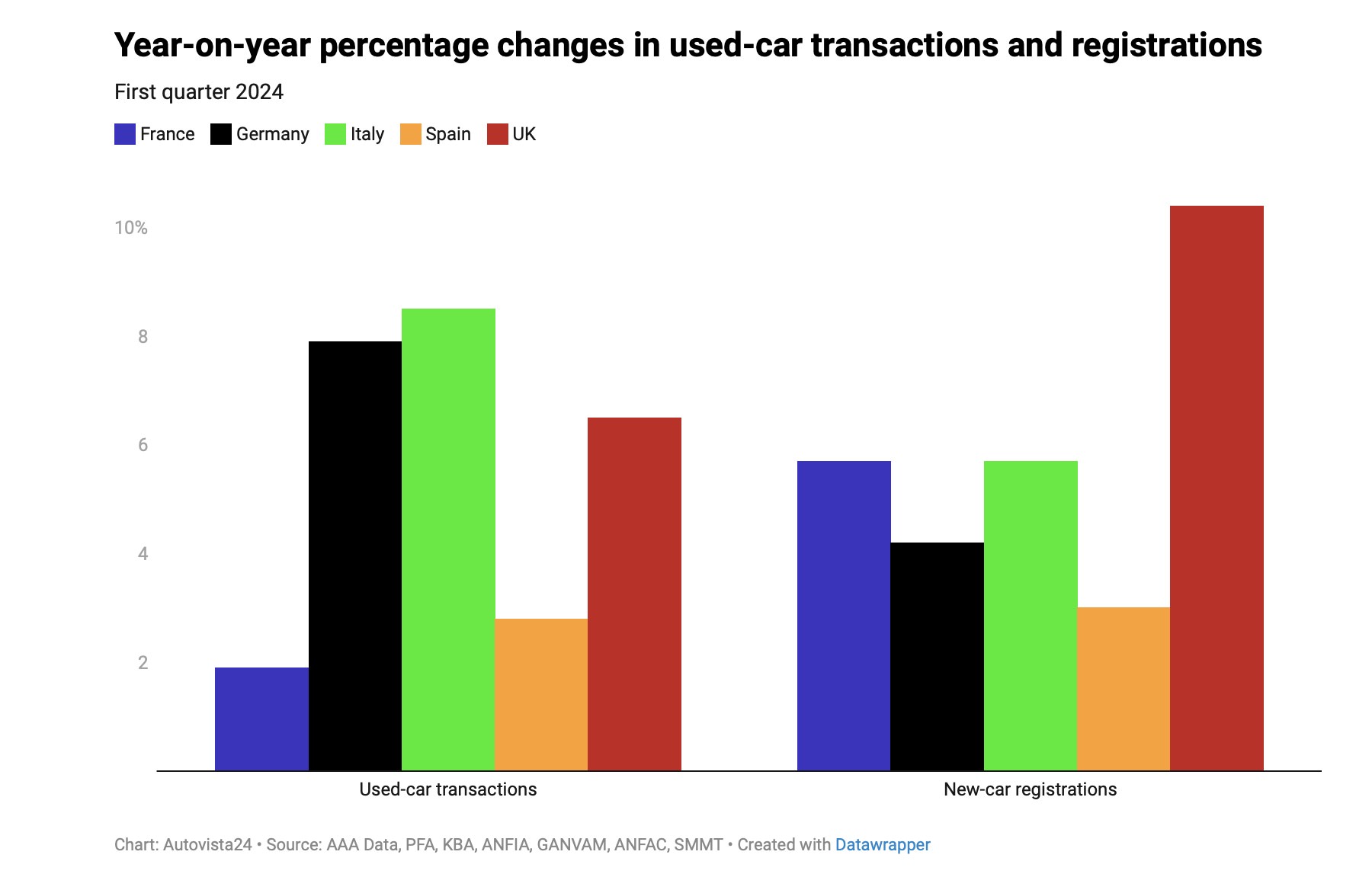
Image source: Autovista24
After the first two quarters of the year, the momentum slowed down a bit. For instance, the German used car market saw only a small growth of 4.6% in May.
The year seems to be ending in the same tone. Near the end of 2024, the supply of used cars has been bigger than demand, states Autovista.
More precisely, the value of used cars—especially EVs—has kept dropping as demand cools off.
For used car dealers, this means it’s best to avoid overstocking and to keep a good mix of petrol cars in the lineup. This way, you’re covering demand for traditional models while managing the slower-moving EV inventory.
What shaped the used car market this year in the EU?
The market has been everything but stable so far. There are two big factors that have influenced buyer behavior, so here’s a breakdown of those.
Economic factors
Although the annual inflation rate in the euro area is steadily getting lower, buyers are still cautious with big purchases like cars. This caution reduced demand for used vehicles, causing prices to drop.
So, if you’re selling luxury cars, you may have seen fewer sales this year. Luckily, there’s still solid demand for more affordable and fuel-efficient models.
Regulatory changes
Car dealers operating in the EU always have to stay on top of new rules that impact their inventory and sales.
For instance, the Euro 7 emissions standard was adopted in April 2024. The Euro 7 regulation set stricter emission limits for cars, vans, and heavy-duty trucks.
Because of these rules, some customers choose to delay buying used vehicles, preferring to wait for models that are fully compliant with the new standards.
Another regulatory change is the EU’s CO₂ emission standards, which aims to reduce emissions by 15% by 2025 and 55% by 2030. This push has made manufacturers introduce more low-emission cars, and that’s another reason why customers may be reluctant to buy older used cars that may not meet the new standards.
Used car market changes by country
You’ve now seen the general state of the market across Europe. But since each local market has its own dynamics, it’s important to look at specific changes in the countries where you’re selling used vehicles.
Germany
While BEV sales aren’t performing too well in Germany, the overall market is relatively stable.
According to the latest Autovista figures, the residual value of passenger cars has remained steady, with only a minor monthly drop of -0.4%, but it’s still down by -6.5% compared to last year.
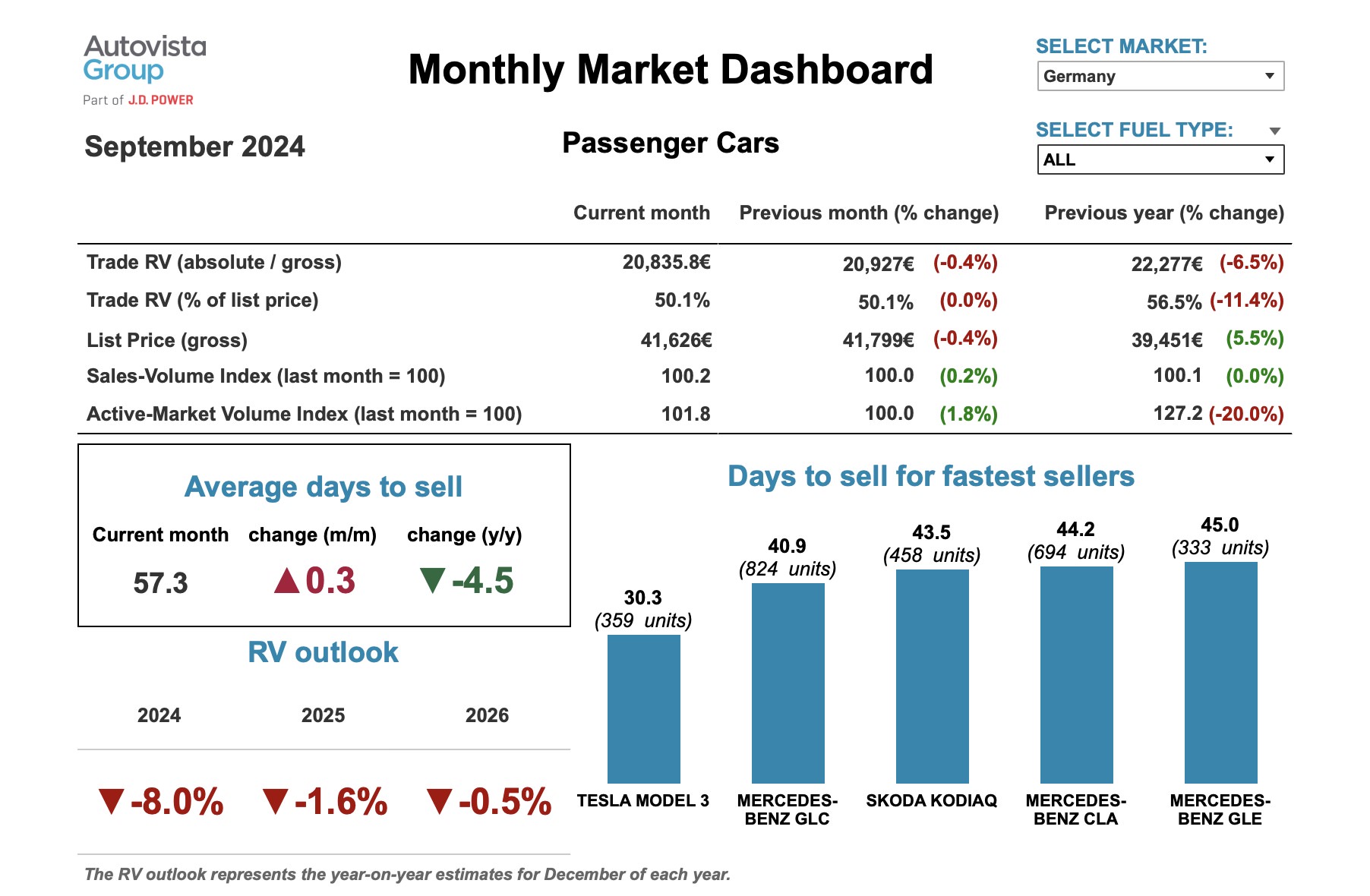
Image source: Autovista24
Still, the sales volume has stayed fairly consistent, which for car dealers means that there’s a steady demand for certain models and car types such as currently popular SUVs.
If you’re wondering which cars to stock at your German used car dealership, you might want to consider the list of fast sellers. Here are the models that have been moving quickly in 2024:
-
Tesla Model 3 - 30 days to sell
-
Mercedes-Benz GLC - 41 days
-
Skoda Kodiaq - 44 days
-
Mercedes-Benz CLA - 44 days
You should also keep in mind that direct EV purchase subsidies ended in 2024, which made EVs less attractive for German buyers.
Still, ownership tax benefits for BEVs registered until the end of 2025 will continue until 2030, and that could help maintain some demand for EVs and hybrids.
Spain
The Spanish market has seen some interesting developments in 2024.
Judging by the sales-volume index, the demand for passenger cars has increased by 11.5% compared to the previous year. However, the active-market volume index in September 2024 shows a -40.4% drop from the previous month, meaning there are fewer cars available for sale.
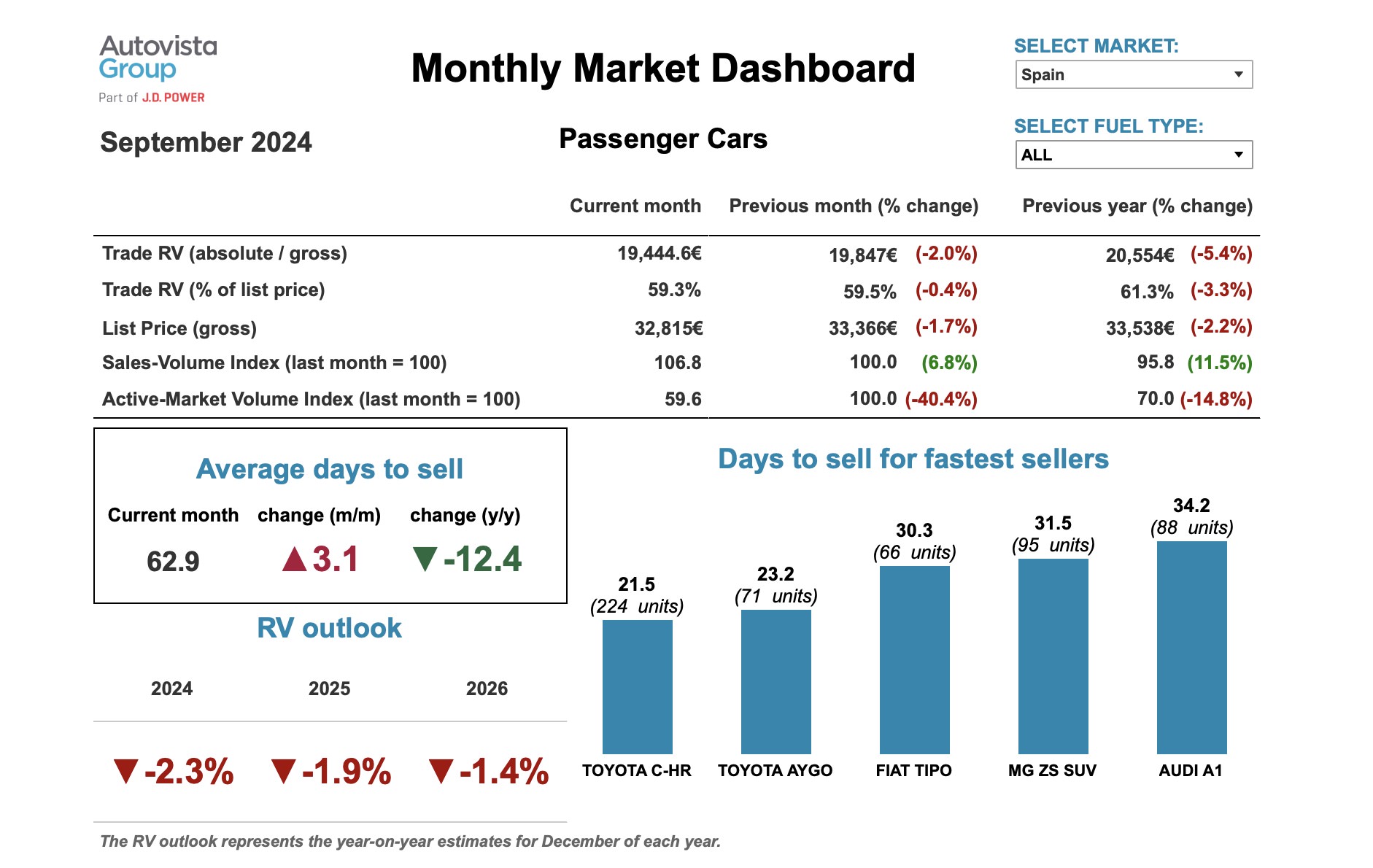
Image source: Autovista24
But before you jump at importing cars into Spain and selling them there, it’s good to keep the recent events in mind. In late October 2024, Spain was hit by severe flash floods which sadly led to over 200 fatalities.
The floods have disrupted the infrastructure and could complicate car logistics and sales. Plus, with many cars damaged in the flooding, the market dynamics for used cars might shift, so you should reassess the situation before making any drastic business moves.
If you do find the situation favorable, here’s an overview of Spanish best-sellers as of September 2024:
-
Toyota C-HR - 22 days to sell
-
Toyota Aygo - 23 days
-
Fiat Tipo - 30 days
-
MG ZS SUV - 32 days
-
Audi A1 - 34 days
Portugal
2024 was overall a good year for Portuguese car dealers. Almost all months saw increased automotive sales in comparison to the previous years, suggesting a stronger demand for cars in Portugal throughout much of 2024.
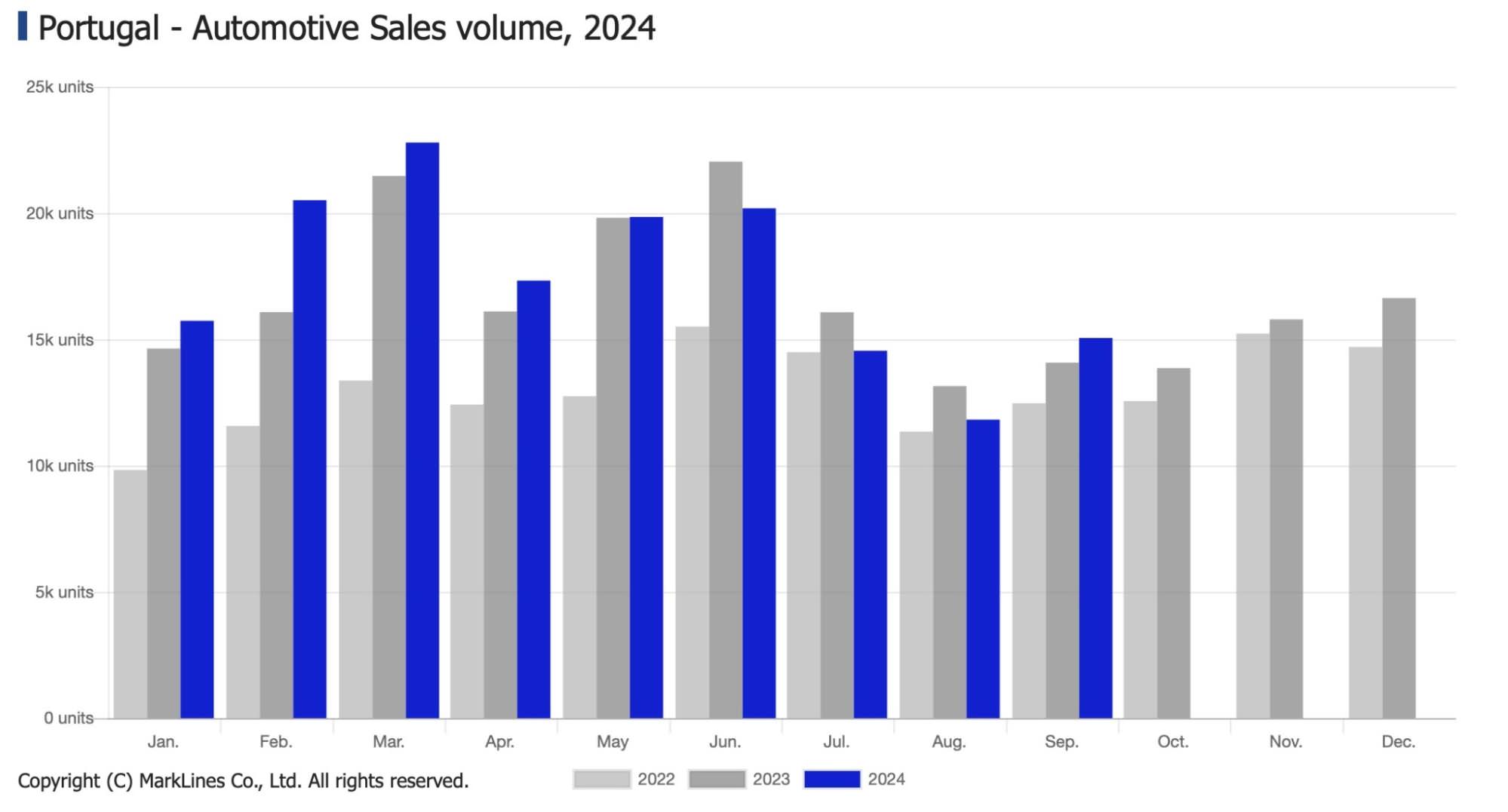
Image source: MarkLines
In terms of brands, Peugeot stayed in first place with 15,503 sales, though this was a 9.7% drop from the previous year.
Dacia moved up to second place with 12,008 units sold, showing an 8.3% increase. Mercedes climbed to third place, selling 11,741 cars.
Rounding out the top brands were Renault and BMW, both experiencing a slight dip in sales.
All in all, if your dealership’s offer includes practical and affordable models, you’re likely in a good spot!
Italy
2024 was not that great for the Italian car market. While there haven’t been any major losses, the market has faced some challenges.
The data from Autovista shows that there was a slight drop in the average residual trade value, and sales volumes have slowed down, with the Sales-Volume Index down by -21.8% from the previous month.
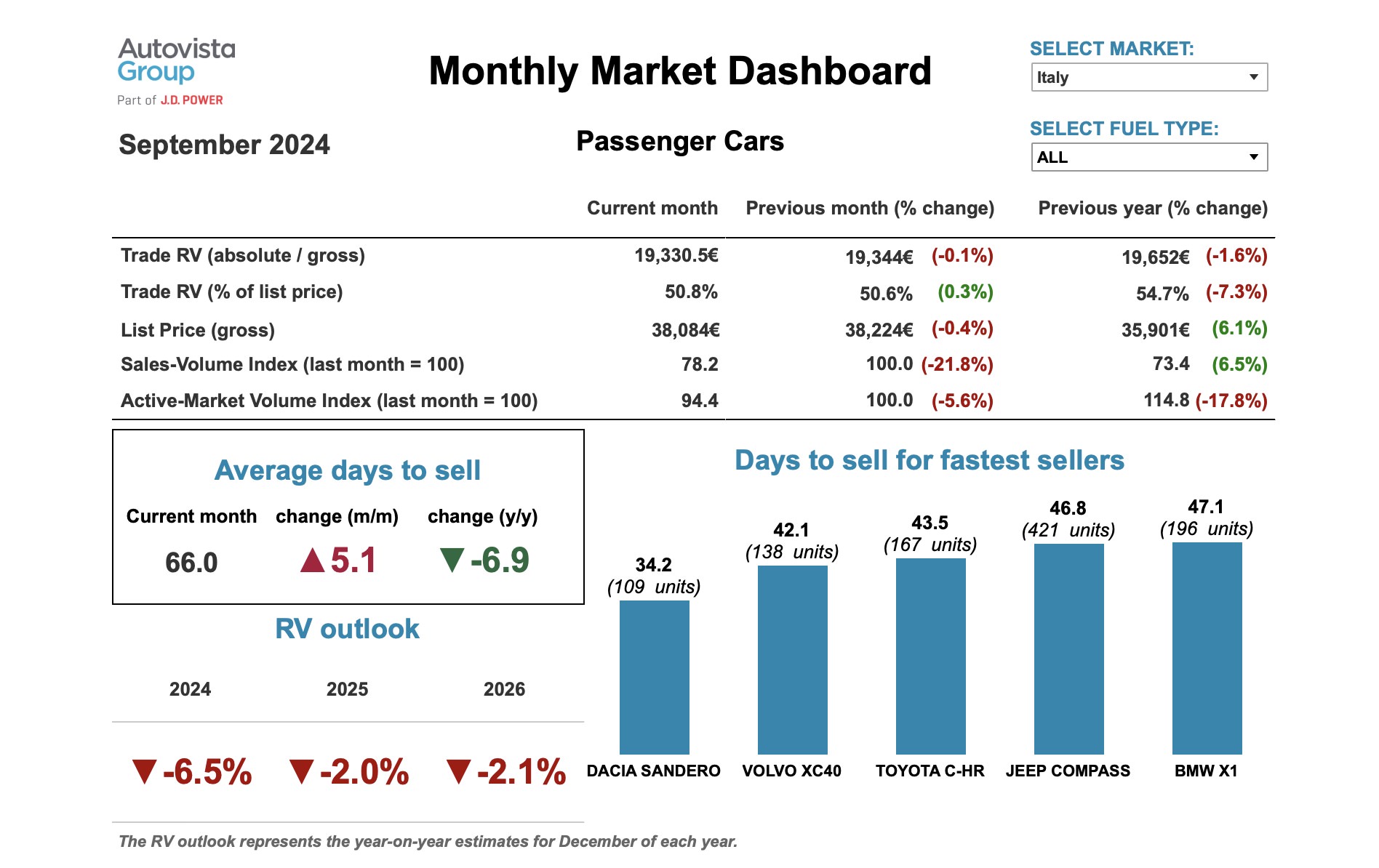
Image source: Autovista24
In other words, demand has cooled, and fewer cars are actively available for sale.
On the positive side, certain models are still selling quickly:
-
Dacia Sandero - 34 days to sell
-
Volvo XC40 - 42 days
-
Toyota C-HR - 44 days
-
Jeep Compass - 47 days
-
BMW X1 - 47 days
For dealers, keeping these popular models in stock could help move cars faster, even with the market slowing down. But with residual values expected to keep dropping, profits might take a hit in 2025.
France
France is another country that has experienced mixed results in the car market this year.
Both the list prices and the residual value of used cars have dropped, which suggests that dealers are cautiously lowering prices to match the cooling demand.
The demand has indeed seen a slowdown, with a -15.2% drop in sales volume from August to September 2024.
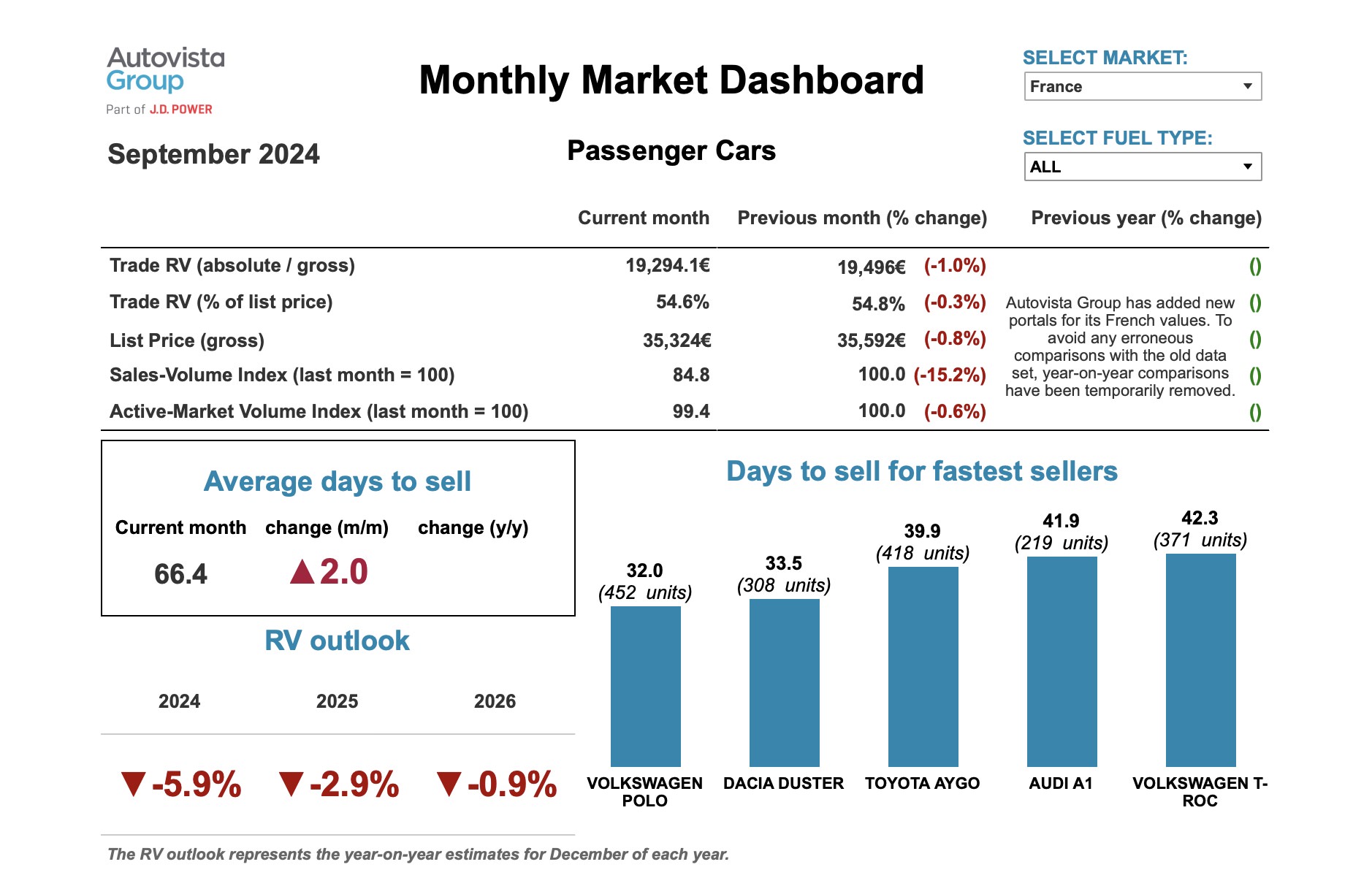
Image source: Autovista24
Not all Autovista figures are negative, though. The active-market volume index only fell by -0.6%, showing that inventory is still moving but at a slower pace. So, while cars are selling, the process is slower, and customers might be more selective.
If you’re looking to increase your chances of quick sales, here’s a list of fastest sellers in 2024 in France:
-
Volkswagen polo - 32 days to sell
-
Dacia Duster - 34 days
-
Toyota Aygo - 40 days
-
Audi A1 - 42 days
-
Volkswagen T-ROC 42 days
So, although demand in France has softened, you can still make the most out of popular, fast-selling models.
Poland
The story of Poland’s current car market actually begins in 2023, when the government launched the “Automotive Discount” program (Dopłata Samochodowa) to encourage buyers to replace older car models with more eco-friendly ones.
This incentive, along with economic conditions, has driven down used car prices, especially for older models. To stay competitive, dealers have increasingly offered discounts, and that has caused prices to steadily decline.
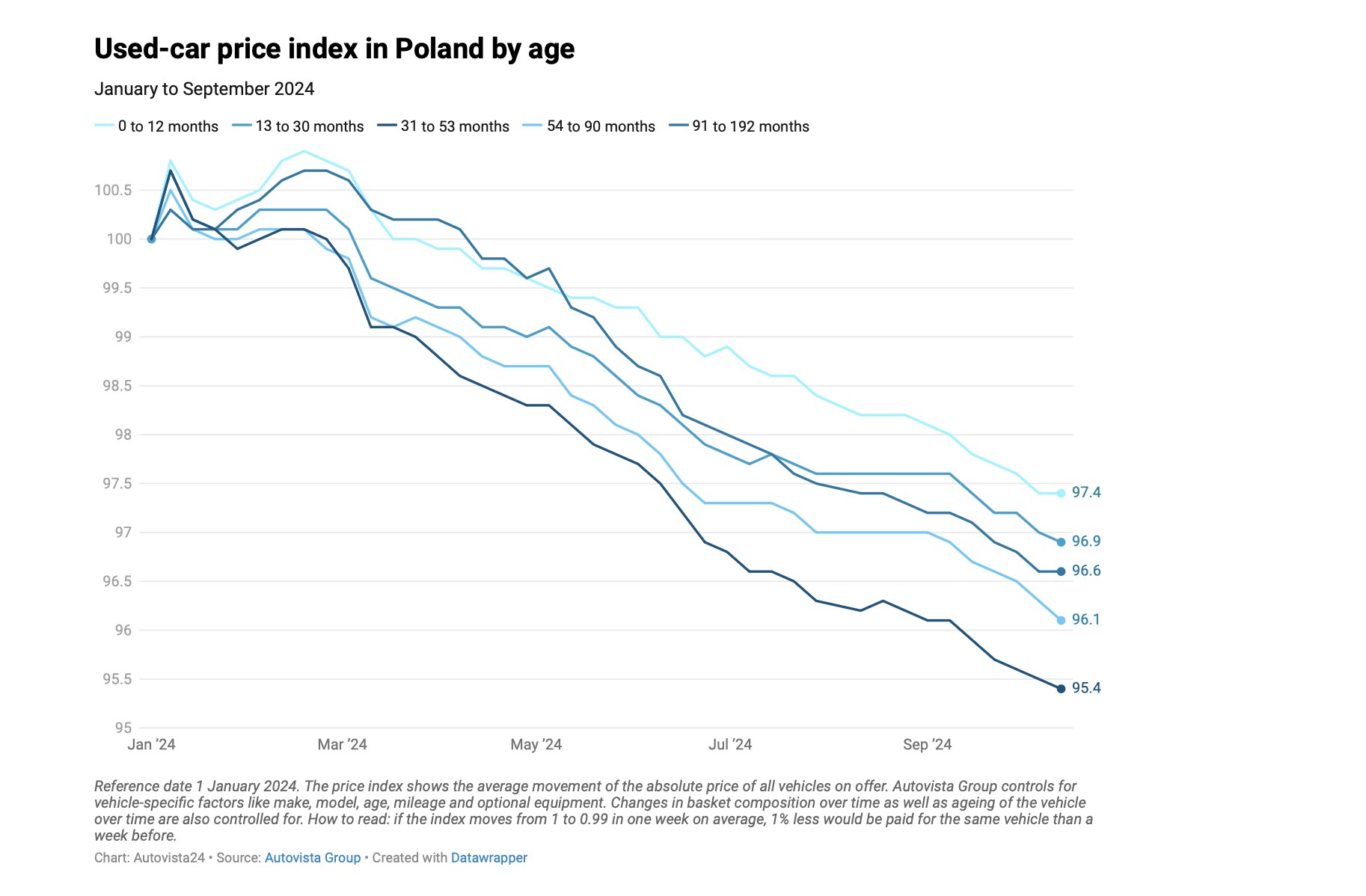
Image source: Autovista24
As you can see in Autovista’s chart above, older vehicles (91 to 192 months) have seen the biggest price drops.
So, for car dealers in Poland, it’s a good idea to focus on affordable, fuel-efficient, and reliable models to match what customers are looking for.
With buyers becoming more price-sensitive, it’s also important to manage inventory and pricing carefully to keep profits steady in this market.
How should you adjust your strategy for Q1 2025?
If the trends remain similar to 2024, your best strategy would be to stock efficient and budget-friendly models. Customers are likely to prioritize value over luxury, so practical models could perform better than high-end ones.
For markets like Germany and Poland, where EV demand is slower, a mix of petrol and hybrid options will help meet diverse needs. In France and Spain, demand is still steady for compact and fuel-efficient models, so targeting these cars could keep your inventory moving.
Finally, keep an eye on regional trends. If certain models are popular in specific markets, consider stocking up on those to meet local demand. By staying flexible and adapting to your market, you’ll be better positioned for a solid start to 2025.
eCarsTrade isn't just an online auction platform - we're also a valuable resource for car dealers and traders. Our blog offers expert advice on various topics, including:

